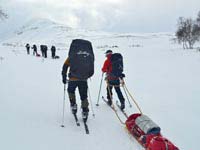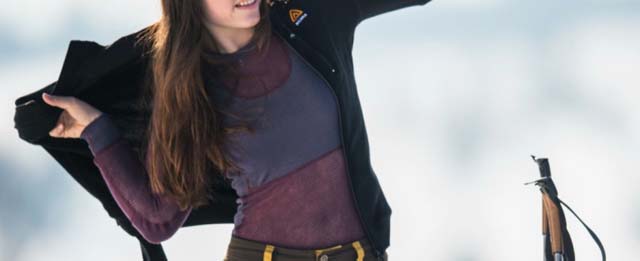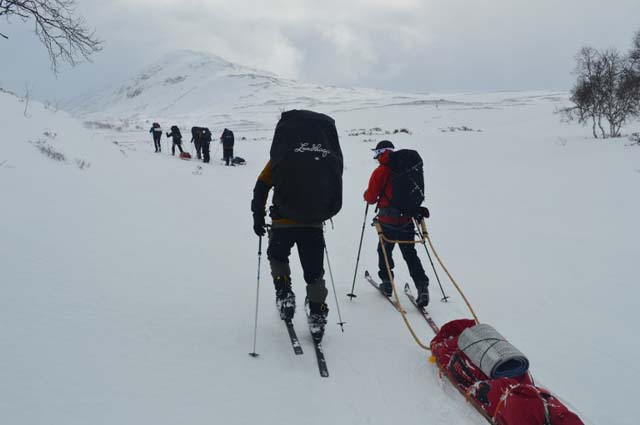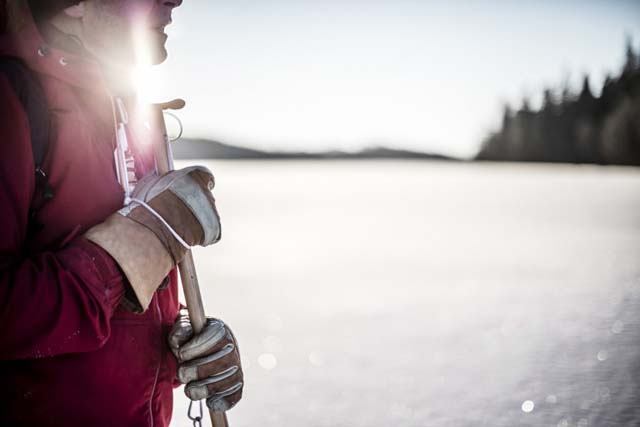
Some expert guidance on how to dress for your next winter adventure such as one of our dogsled tours or ski touring expeditions.
There’s nothing quite like winter. In fact, there’s nothing quite like winter in Scandinavia. Sub-zero temperatures, snow as far as the eye can see, and clear blue skies. It really is something to behold. While admiring it is easy, dressing for activity in these conditions isn’t always as straightforward.
Scandinavians love their layers. To begin to understand why, it’s important to know that outdoor clothing doesn’t actually keep you warm. What they do is retain the warmth your body create. Insulation in outdoor clothing basically comes down to trapping pockets of air heated by your body, which then provides a protective layer against the cold outside. Obviously, the rate at which you warm the air that is trapped by your clothing varies, depending on what you do.
If you get too hot, the body’s natural way to cool you down is through the evaporation of moisture through the skin. In other words, sweating. This works terrific in warm conditions, in cold conditions the effect when the moisture cools can be anything from uncomfortable to dangerous.

Because of this, it is really important that you think about what you are wearing and that you adapt your layers according to the activity.
The principle of layering comes down to wearing an outer layer, a reinforcement layer, and a baselayer. The outer layer is a usually a shell jacket, designed to protect you from what the elements throws at you. The next layer is the reinforcement layer, which is there to provide extra insulation when needed. Closest to the skin you should wear something that will wick moisture away from your body, while still providing insulation from the outside. By taking these layers on or off, you will be able to adjust to the level of activity you are undertaking.
But just having a layering system in place will do little if you are not using it correctly. In fact, the whole point of the system is that all the individual pieces will rarely be used at the same time.
Wearing more, or thicker, layers than you need to often leads to both the layers you are wearing underneath and your body becoming overloaded. The result will be layers that won’t work as well when you actually need them.

It is very tempting to wear your nice and thick fleece or wool jacket when you are starting out. However, it is in fact a lot better to be a little cold in the parking lot than to quickly overheat when you start exerting yourself. The reinforcement layer is for the breaks, when you need a little extra warmth to maintain an even core temperature. In those cases, you don’t want to be left with a jacket soaked in sweat as your only option.
In cold weather the reaction to every action tends to be even more pronounced than in milder climates. Consider this: much of the heat leaving the body is lost through the neck and head. Think about this next time you are looking up a steep slope. It might be worth taking your hat off before you start making your way up, rather than keeping it on and then taking the sweat soaked hat off at the top. Doing this will lead to a rapid loss of heat. In response, the body will reduce the blood flow to your hands and feet, to maintain an even temperature in the parts of the body deemed more important. So, wearing a hat in the wrong situation can leave you with cold hands and feet.
The key to using a layering system effectively is staying balanced. This means that there will be a lot of dressing and undressing to adapt to what you are doing. While this will in some ways will mean more work, it will soon become second nature and keep you more comfortable.

Besides making you feel more comfortable, an even body temperature will also increase your endurance since your body won’t have to work as hard at either warming you up or cooling you down.
Not all these changes to your outfit have to be big. A lot can be done by adding or removing smaller accessories. Something people often forget is that the same layering principle that you are using for your body should be used for your head, hands, and feet. Using headovers and liner gloves are good ways of easily adjusting your outfit.
The ease with which you can adapt to different requirements is the beauty of the layering system, and why it has been so popular in Scandinavia over the centuries. The extra effort is easily outweighed by the added comfort, allowing you to truly enjoy the outdoors.
Find out more about layering up for your trip at www.nordicoutdoor.co.uk
